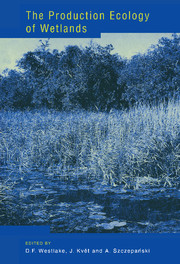Book contents
- Frontmatter
- Contents
- List of contributors
- Preface
- Foreword
- 1 General ecology of wetlands
- 2 Primary production in wetlands
- 3 Further fate of organic matter in wetlands
- 4 The role of decomposers in wetlands
- 5 The role of animals and animal communities in wetlands
- 6 Mineral economy and cycling of minerals in wetlands
- 7 Micro-climatic conditions and water economy of wetlands vegetation
- 8 The management of wetlands
- References
- Index
1 - General ecology of wetlands
Published online by Cambridge University Press: 27 October 2009
- Frontmatter
- Contents
- List of contributors
- Preface
- Foreword
- 1 General ecology of wetlands
- 2 Primary production in wetlands
- 3 Further fate of organic matter in wetlands
- 4 The role of decomposers in wetlands
- 5 The role of animals and animal communities in wetlands
- 6 Mineral economy and cycling of minerals in wetlands
- 7 Micro-climatic conditions and water economy of wetlands vegetation
- 8 The management of wetlands
- References
- Index
Summary
Introduction
Like all the chapters of this book, this is a co-operative work, written by the two main authors, with a contribution on geographical distribution by I.M. Raspopov, and with the help of comments from colleagues and the three editors.
The term ‘wetland’ came into use in the 1970s and was soon generally accepted. There is, however, not much agreement about its limits, which are sometimes denned very broadly, and sometimes very narrowly. Generally speaking, wetlands may be denned as habitats where the water table is situated at or near the ground surface, bearing a vegetation adapted to more or less continuous waterlogging (cf. Sjörs, 1948; Ratcliffe, 1964). ‘Near’ may mean either under or above the ground level.
This definition proves to be vague if we try to fix the limits of wetlands. There is no doubt that littoral habitats and marshes belong to wetlands, but there is less agreement about open water, coastal habitats, mangrove swamps, wet heaths, peat bogs, carrs, and habitats which are waterlogged for only certain periods. One difficulty is that wetlands are very often successional stages. Succession seres often start from open water, under which bottom deposits accumulate gradually causing the community to change over long periods.
Another difficulty arises where the water level changes considerably within brief periods, and the habitat may be waterlogged or flooded only for several short periods per season, or not at all in some years, or as in desert climates, it may be dry for even longer.
- Type
- Chapter
- Information
- The Production Ecology of WetlandsThe IBP Synthesis, pp. 1 - 77Publisher: Cambridge University PressPrint publication year: 1999
- 2
- Cited by



